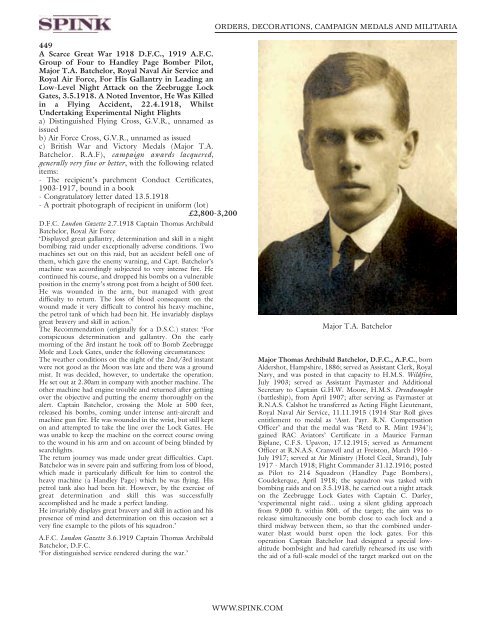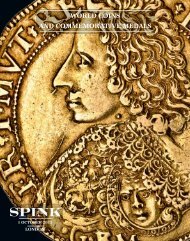orders, decorations, campaign medals and militaria - Spink
orders, decorations, campaign medals and militaria - Spink
orders, decorations, campaign medals and militaria - Spink
Create successful ePaper yourself
Turn your PDF publications into a flip-book with our unique Google optimized e-Paper software.
449<br />
A Scarce Great War 1918 D.F.C., 1919 A.F.C.<br />
Group of Four to H<strong>and</strong>ley Page Bomber Pilot,<br />
Major T.A. Batchelor, Royal Naval Air Service <strong>and</strong><br />
Royal Air Force, For His Gallantry in Leading an<br />
Low-Level Night Attack on the Zeebrugge Lock<br />
Gates, 3.5.1918. A Noted Inventor, He Was Killed<br />
in a Flying Accident, 22.4.1918, Whilst<br />
Undertaking Experimental Night Flights<br />
a) Distinguished Flying Cross, G.V.R., unnamed as<br />
issued<br />
b) Air Force Cross, G.V.R., unnamed as issued<br />
c) British War <strong>and</strong> Victory Medals (Major T.A.<br />
Batchelor. R.A.F), <strong>campaign</strong> awards lacquered,<br />
generally very fine or better, with the following related<br />
items:<br />
- The recipient’s parchment Conduct Certificates,<br />
1903-1917, bound in a book<br />
- Congratulatory letter dated 13.5.1918<br />
- A portrait photograph of recipient in uniform (lot)<br />
£2,800-3,200<br />
D.F.C. London Gazette 2.7.1918 Captain Thomas Archibald<br />
Batchelor, Royal Air Force<br />
‘Displayed great gallantry, determination <strong>and</strong> skill in a night<br />
bomlbing raid under exceptionally adverse conditions. Two<br />
machines set out on this raid, but an accident befell one of<br />
them, which gave the enemy warning, <strong>and</strong> Capt. Batchelor’s<br />
machine was accordingly subjected to very intense fire. He<br />
continued his course, <strong>and</strong> dropped his bombs on a vulnerable<br />
position in the enemy’s strong post from a height of 500 feet.<br />
He was wounded in the arm, but managed with great<br />
difficulty to return. The loss of blood consequent on the<br />
wound made it very difficult to control his heavy machine,<br />
the petrol tank of which had been hit. He invariably displays<br />
great bravery <strong>and</strong> skill in action.’<br />
The Recommendation (originally for a D.S.C.) states: ‘For<br />
conspicuous determination <strong>and</strong> gallantry. On the early<br />
morning of the 3rd instant he took off to Bomb Zeebrugge<br />
Mole <strong>and</strong> Lock Gates, under the following circumstances:<br />
The weather conditions on the night of the 2nd/3rd instant<br />
were not good as the Moon was late <strong>and</strong> there was a ground<br />
mist. It was decided, however, to undertake the operation.<br />
He set out at 2.30am in company with another machine. The<br />
other machine had engine trouble <strong>and</strong> returned after getting<br />
over the objective <strong>and</strong> putting the enemy thoroughly on the<br />
alert. Captain Batchelor, crossing the Mole at 500 feet,<br />
released his bombs, coming under intense anti-aircraft <strong>and</strong><br />
machine gun fire. He was wounded in the wrist, but still kept<br />
on <strong>and</strong> attempted to take the line over the Lock Gates. He<br />
was unable to keep the machine on the correct course owing<br />
to the wound in his arm <strong>and</strong> on account of being blinded by<br />
searchlights.<br />
The return journey was made under great difficulties. Capt.<br />
Batchelor was in severe pain <strong>and</strong> suffering from loss of blood,<br />
which made it particularly difficult for him to control the<br />
heavy machine (a H<strong>and</strong>ley Page) which he was flying. His<br />
petrol tank also had been hit. However, by the exercise of<br />
great determination <strong>and</strong> skill this was successfully<br />
accomplished <strong>and</strong> he made a perfect l<strong>and</strong>ing.<br />
He invariably displays great bravery <strong>and</strong> skill in action <strong>and</strong> his<br />
presence of mind <strong>and</strong> determination on this occasion set a<br />
very fine example to the pilots of his squadron.’<br />
A.F.C. London Gazette 3.6.1919 Captain Thomas Archibald<br />
Batchelor, D.F.C.<br />
‘For distinguished service rendered during the war.’<br />
<strong>orders</strong>, deCoratioNs, CampaigN medaLs aNd miLitaria<br />
WWW.spiNK.Com<br />
Major T.A. Batchelor<br />
Major Thomas Archibald Batchelor, D.F.C., A.F.C., born<br />
Aldershot, Hampshire, 1886; served as Assistant Clerk, Royal<br />
Navy, <strong>and</strong> was posted in that capacity to H.M.S. Wildfire,<br />
July 1903; served as Assistant Paymaster <strong>and</strong> Additional<br />
Secretary to Captain G.H.W. Moore, H.M.S. Dreadnought<br />
(battleship), from April 1907; after serving as Paymaster at<br />
R.N.A.S. Calshot he transferred as Acting Flight Lieutenant,<br />
Royal Naval Air Service, 11.11.1915 (1914 Star Roll gives<br />
entitlement to medal as ‘Asst. Payr. R.N. Compensation<br />
Officer’ <strong>and</strong> that the medal was ‘Retd to R. Mint 1934’);<br />
gained RAC Aviators’ Certificate in a Maurice Farman<br />
Biplane, C.F.S. Upavon, 17.12.1915; served as Armament<br />
Officer at R.N.A.S. Cranwell <strong>and</strong> at Freiston, March 1916 -<br />
July 1917; served at Air Ministry (Hotel Cecil, Str<strong>and</strong>), July<br />
1917 - March 1918; Flight Comm<strong>and</strong>er 31.12.1916; posted<br />
as Pilot to 214 Squadron (H<strong>and</strong>ley Page Bombers),<br />
Coudekerque, April 1918; the squadron was tasked with<br />
bombing raids <strong>and</strong> on 3.5.1918, he carried out a night attack<br />
on the Zeebrugge Lock Gates with Captain C. Darley,<br />
‘experimental night raid... using a silent gliding approach<br />
from 9,000 ft. within 80ft. of the target; the aim was to<br />
release simultaneously one bomb close to each lock <strong>and</strong> a<br />
third midway between them, so that the combined underwater<br />
blast would burst open the lock gates. For this<br />
operation Captain Batchelor had designed a special lowaltitude<br />
bombsight <strong>and</strong> had carefully rehearsed its use with<br />
the aid of a full-scale model of the target marked out on the

















